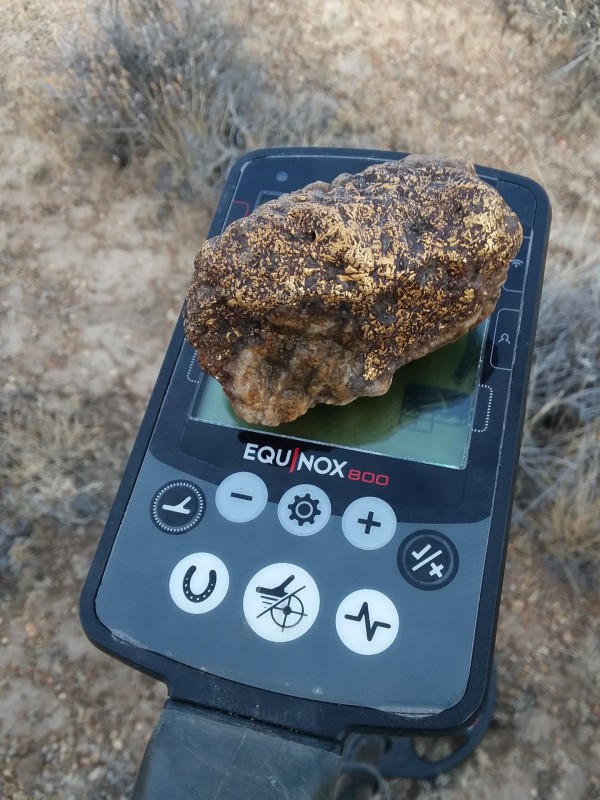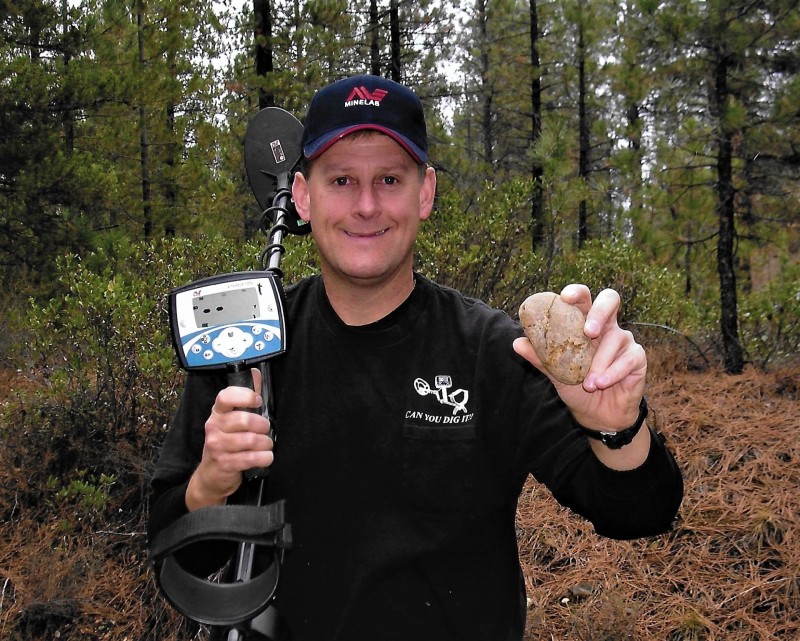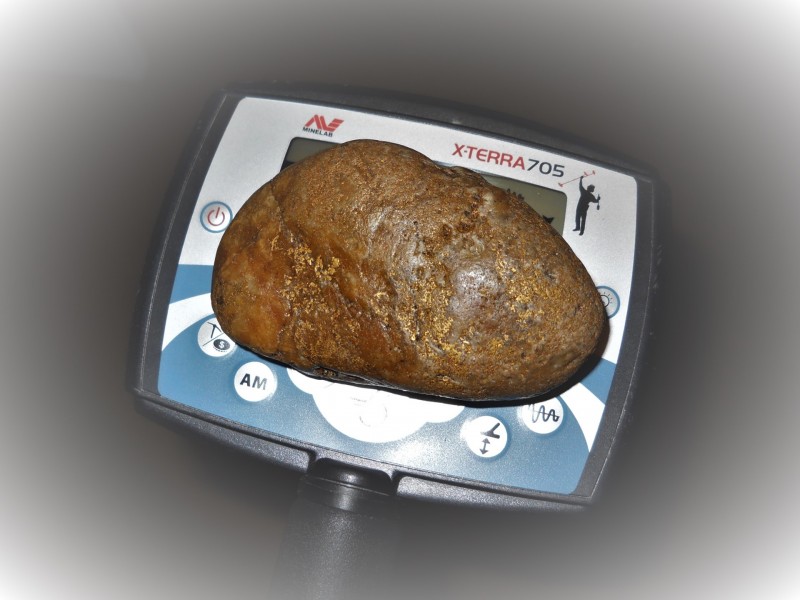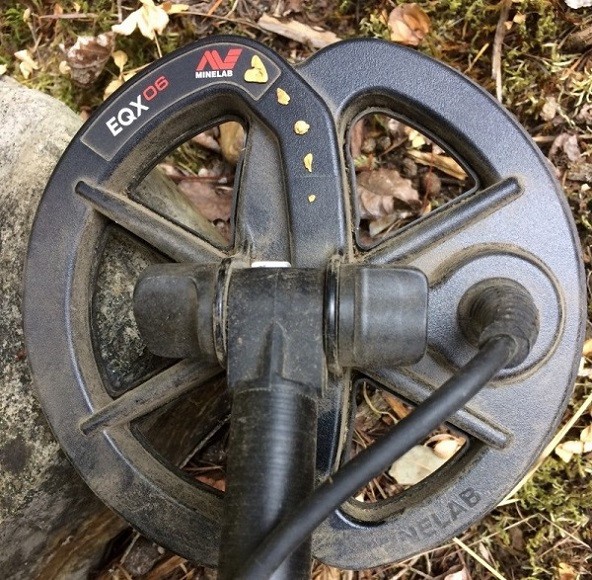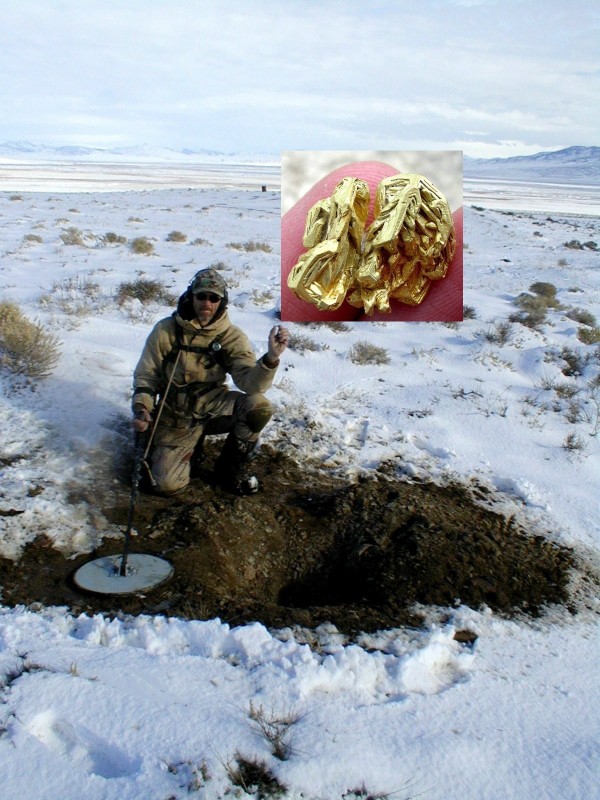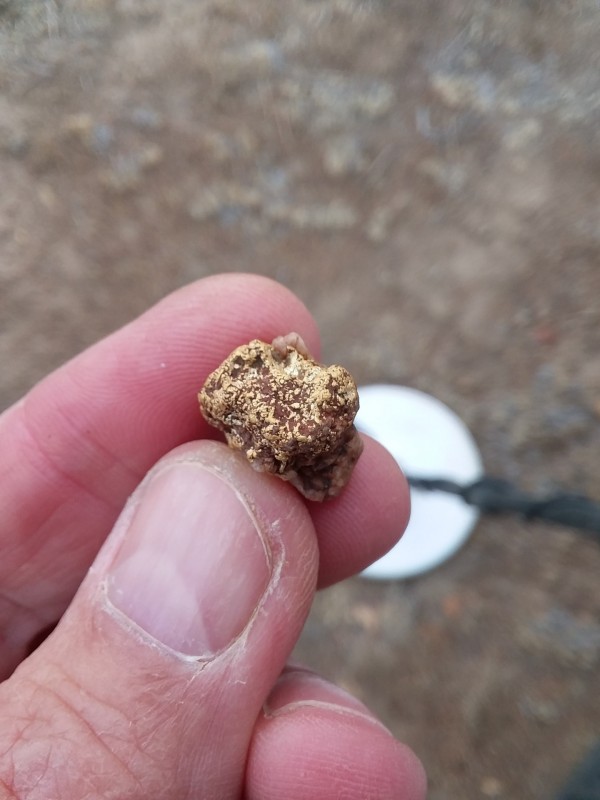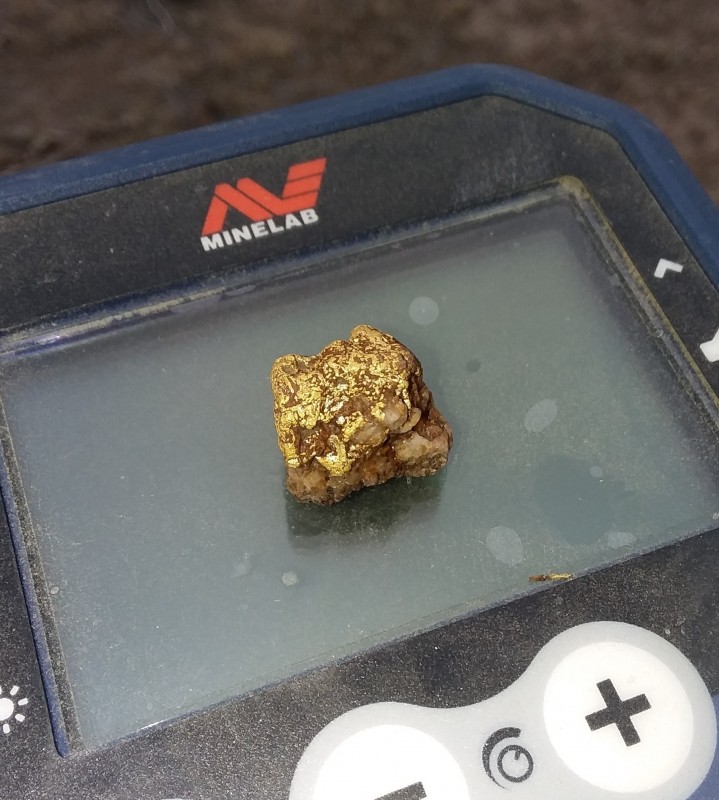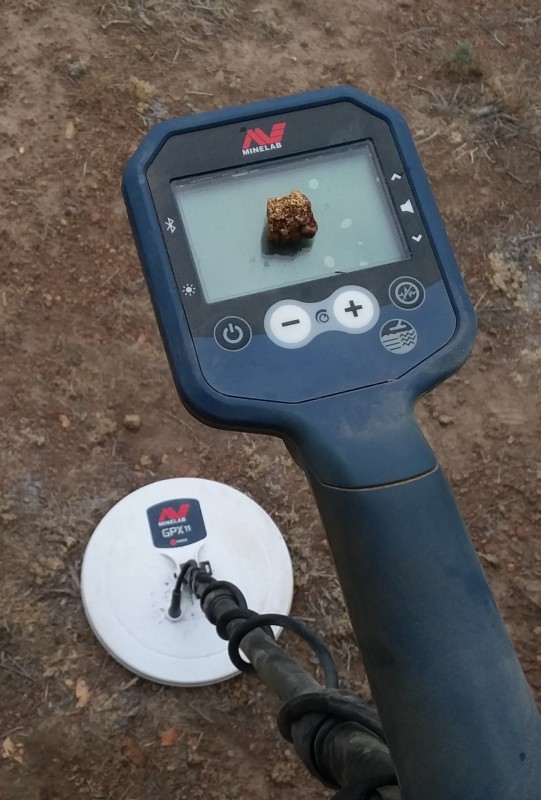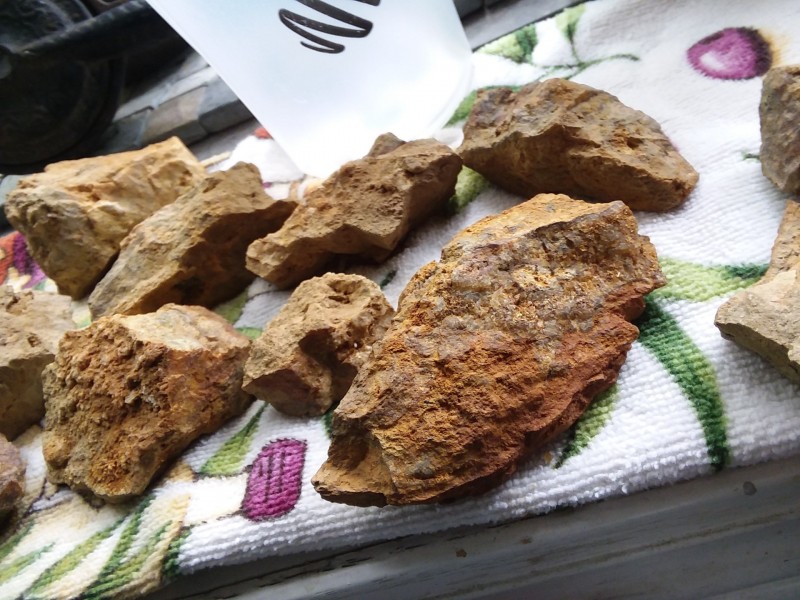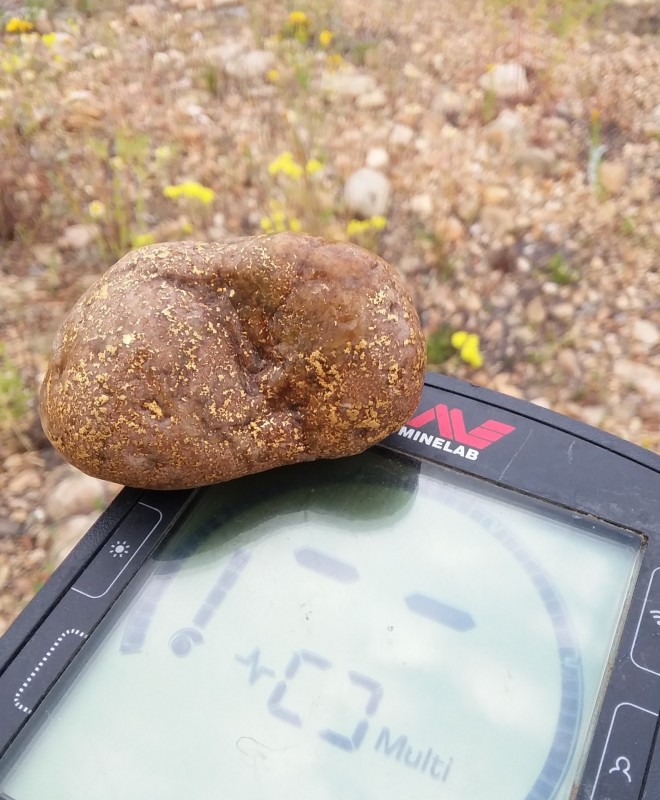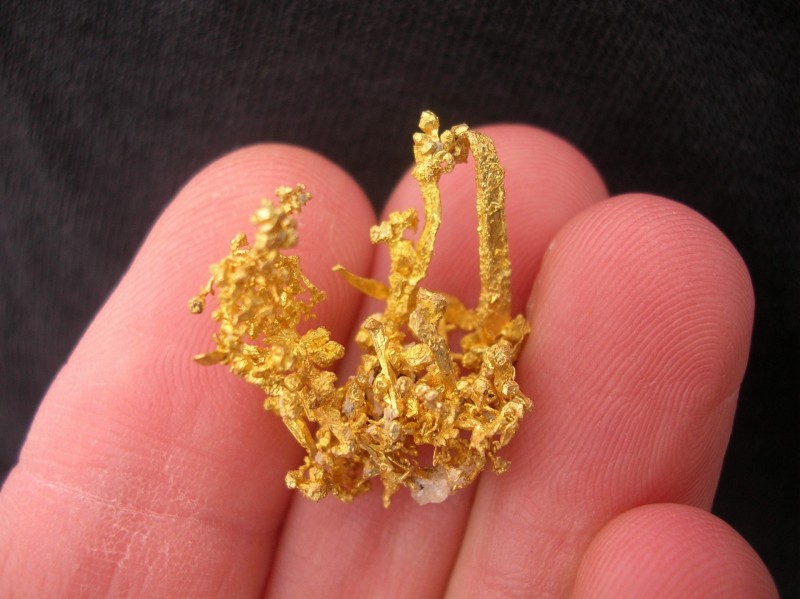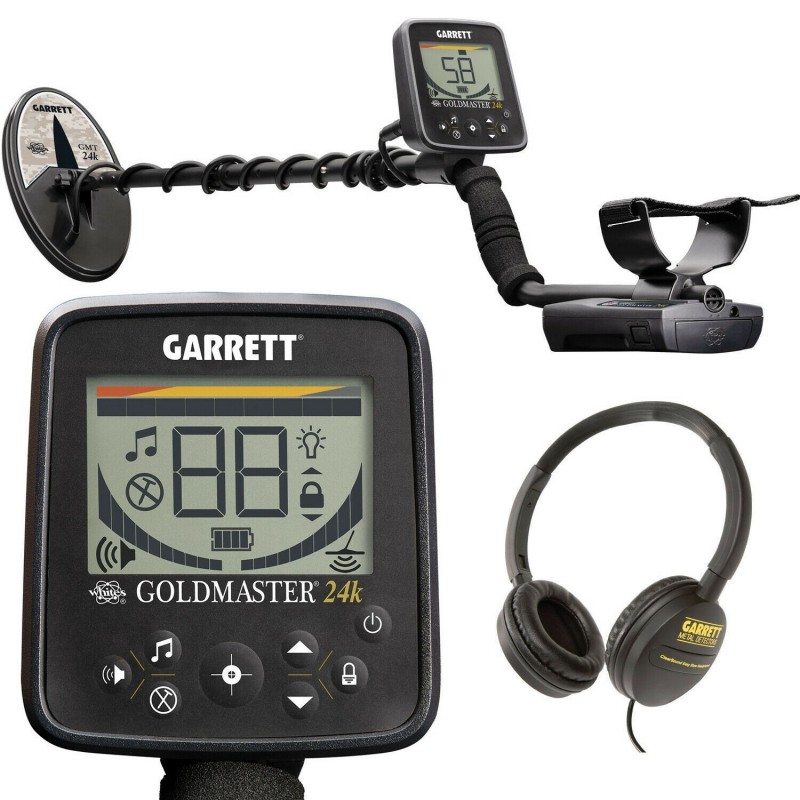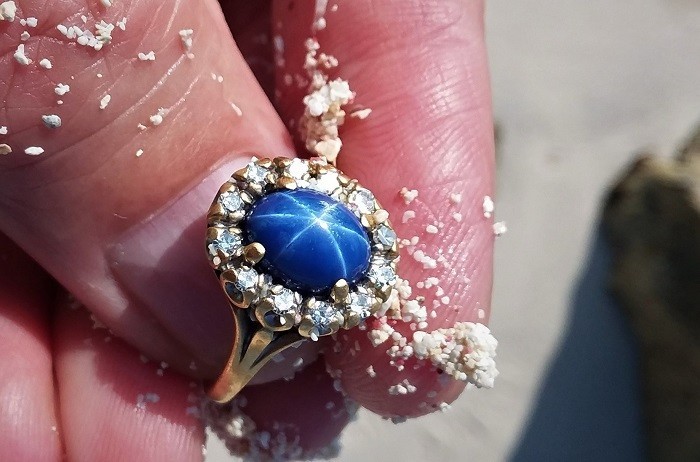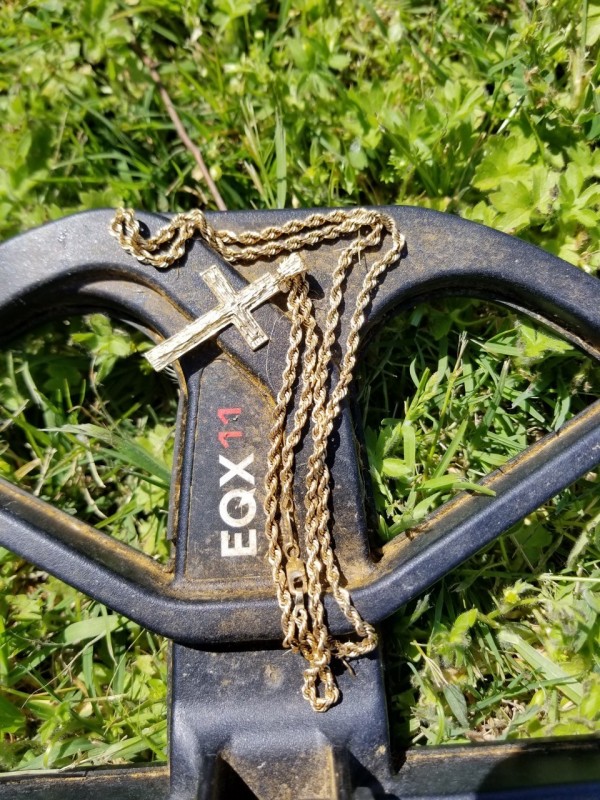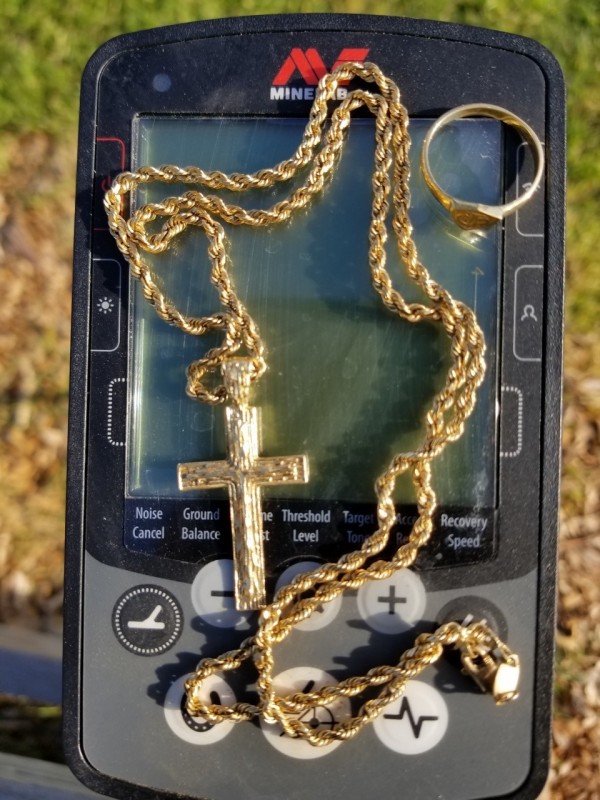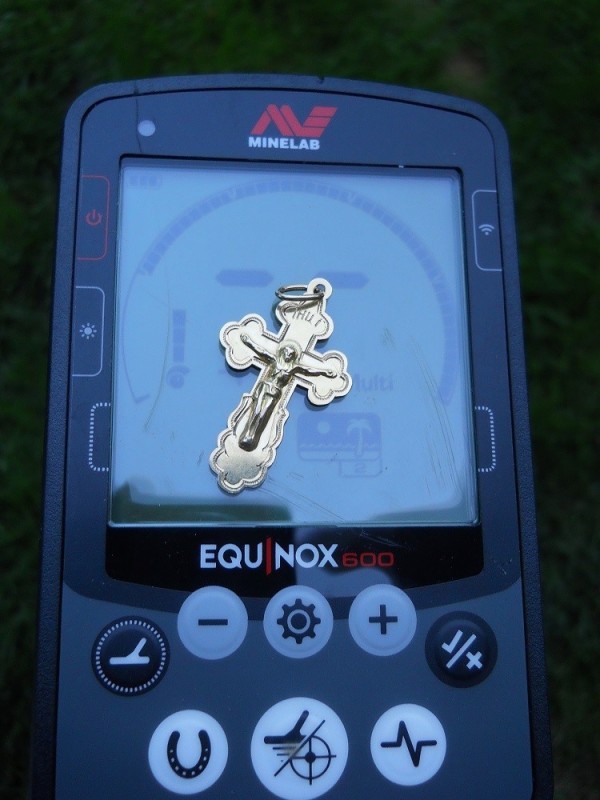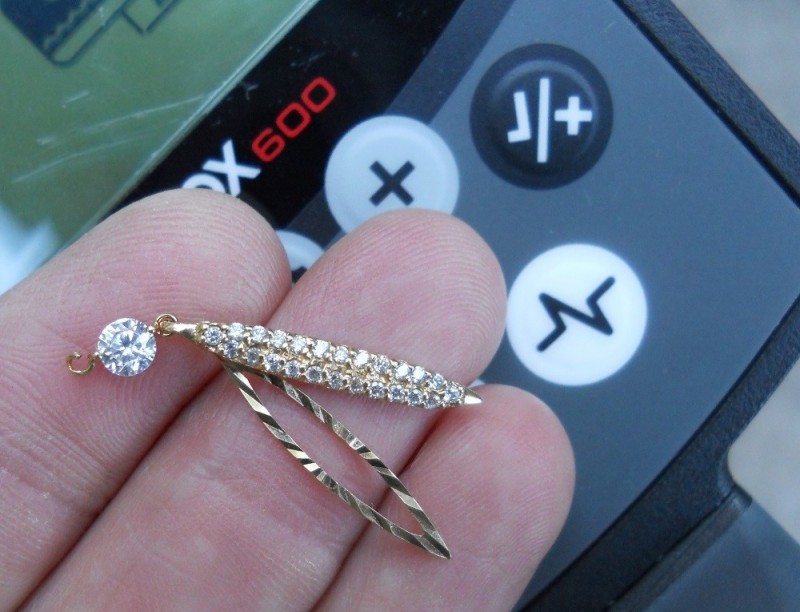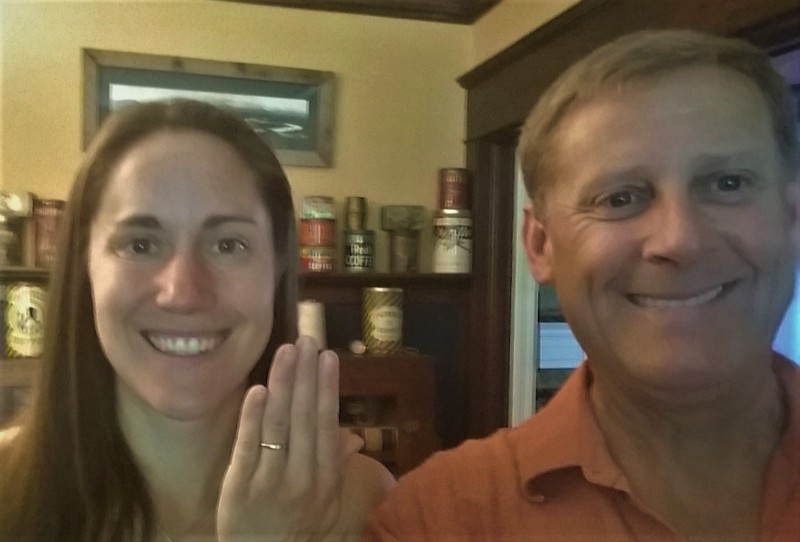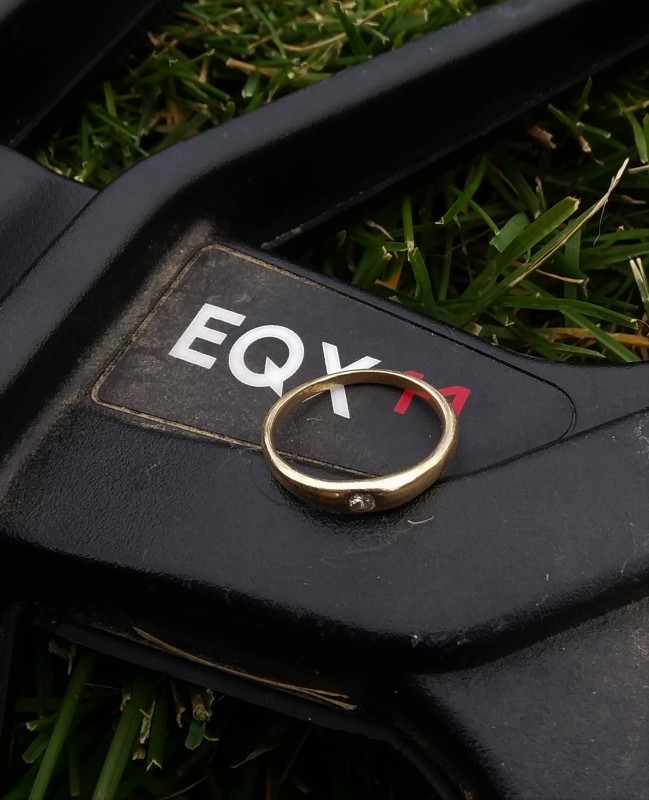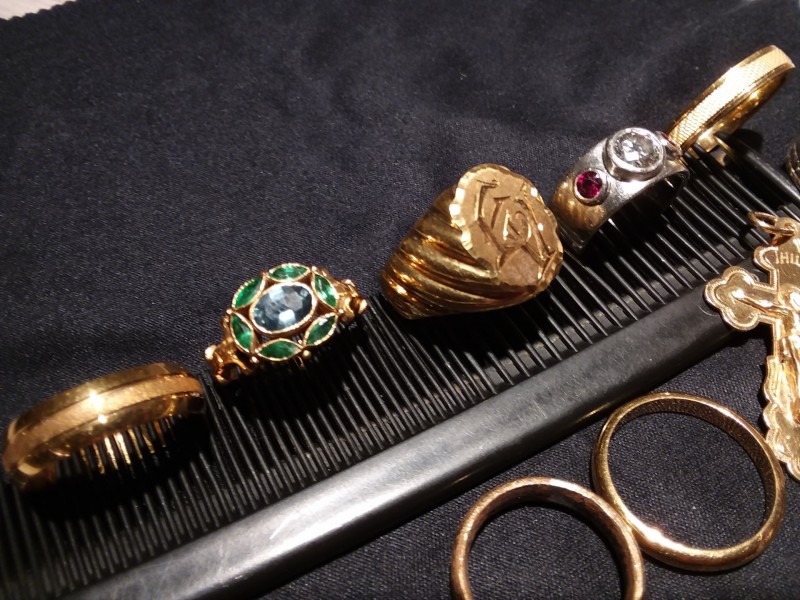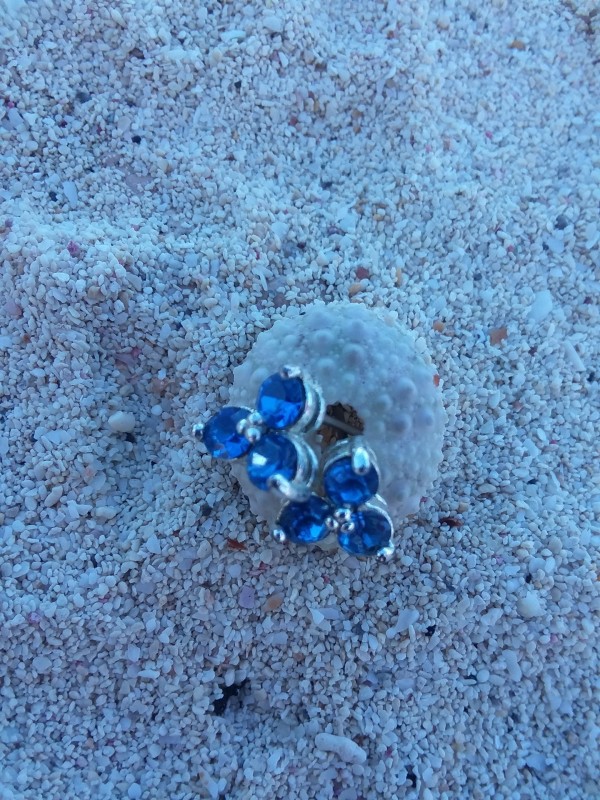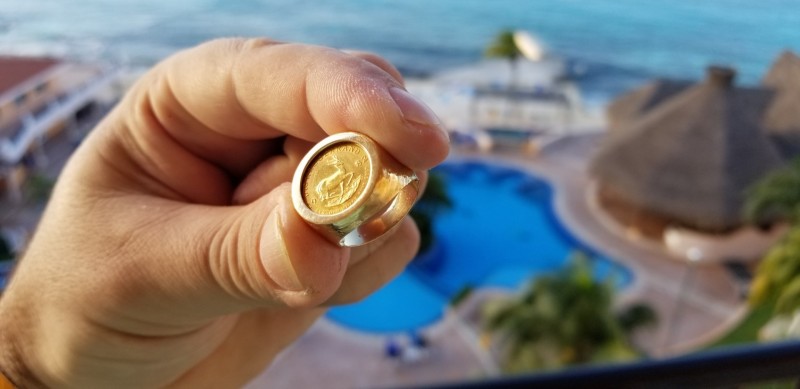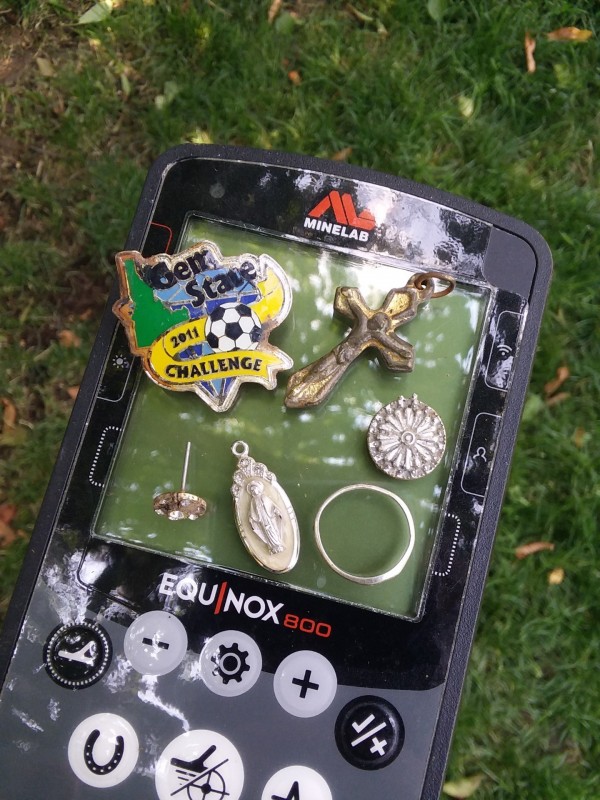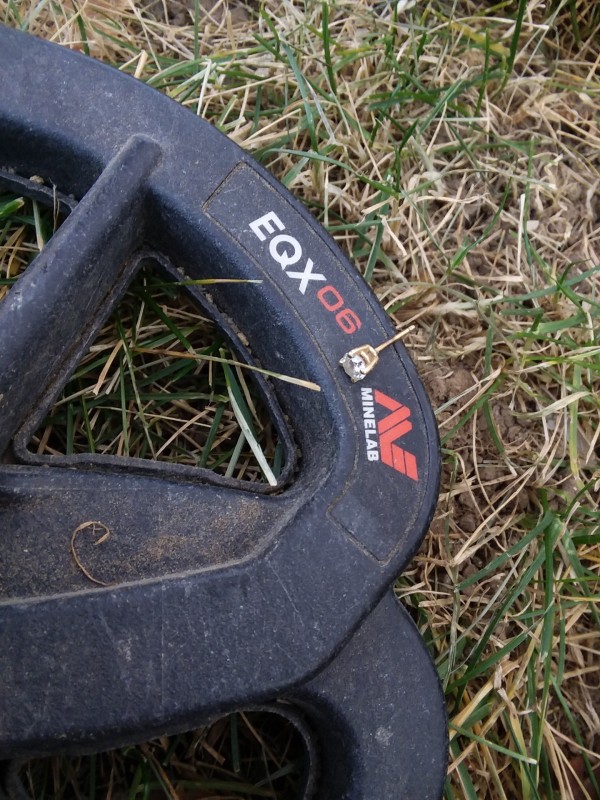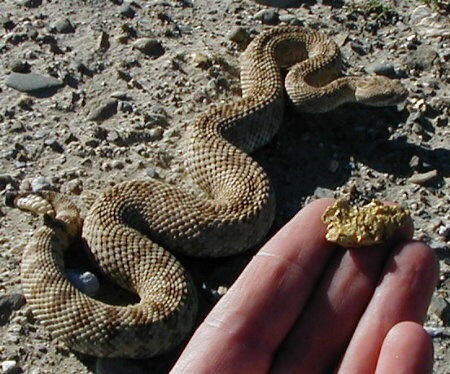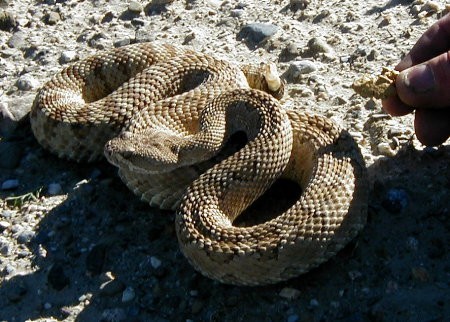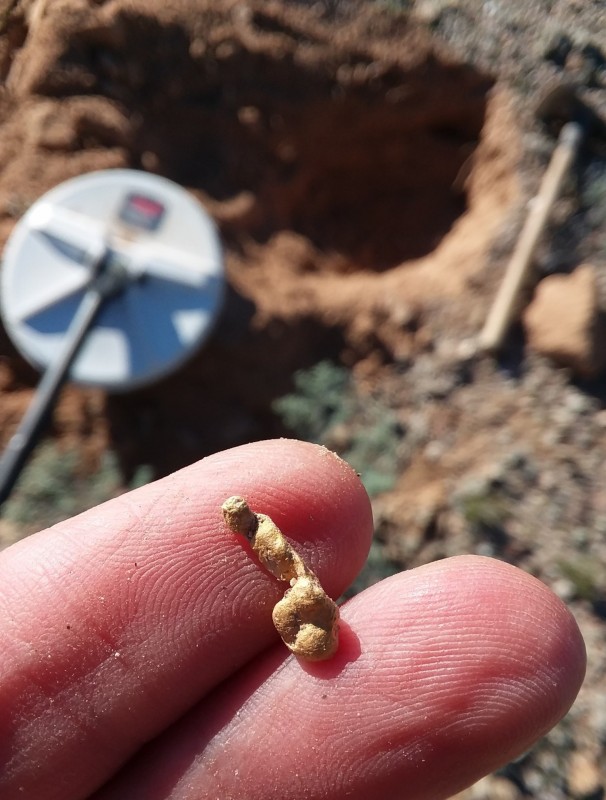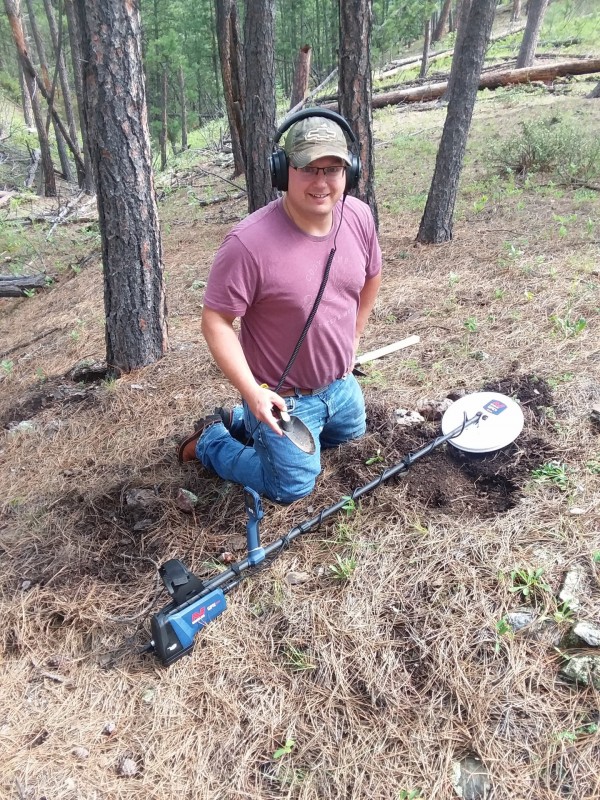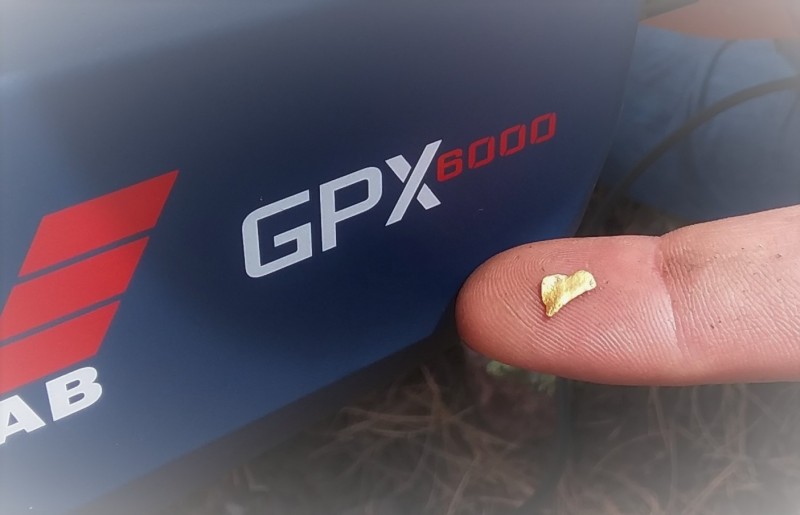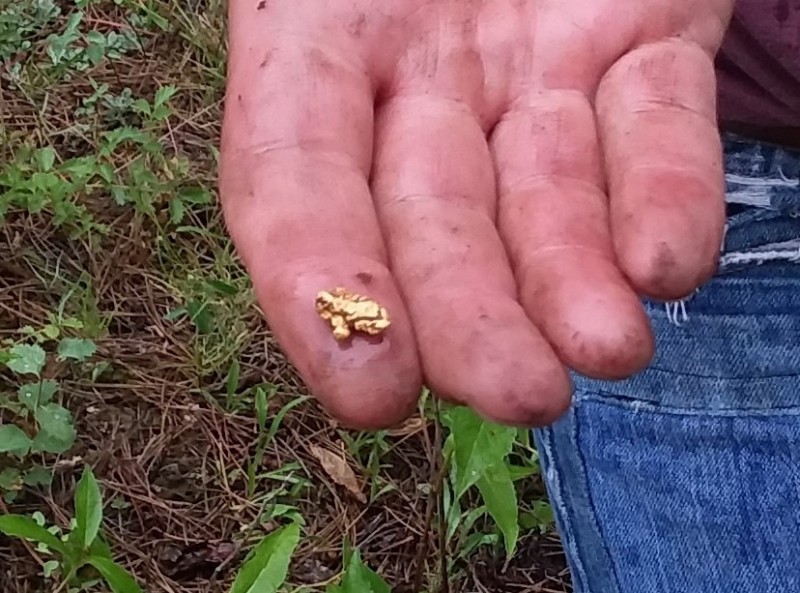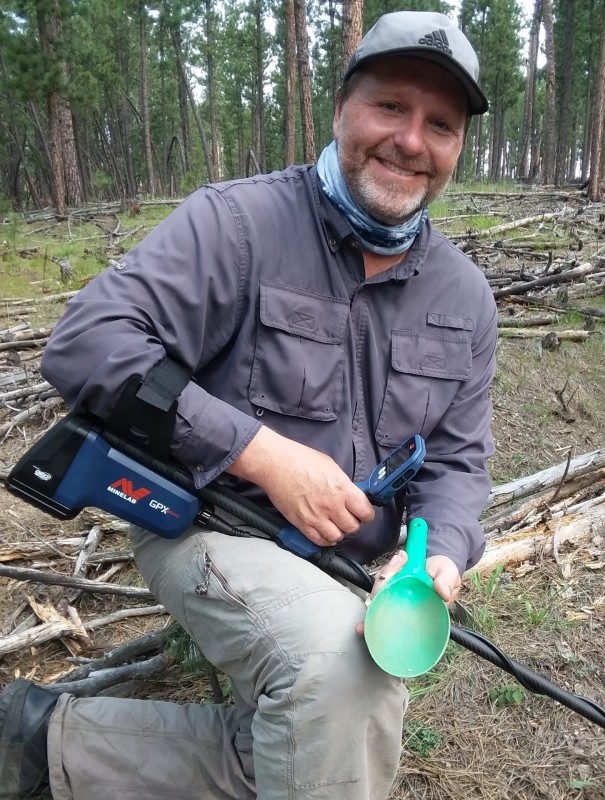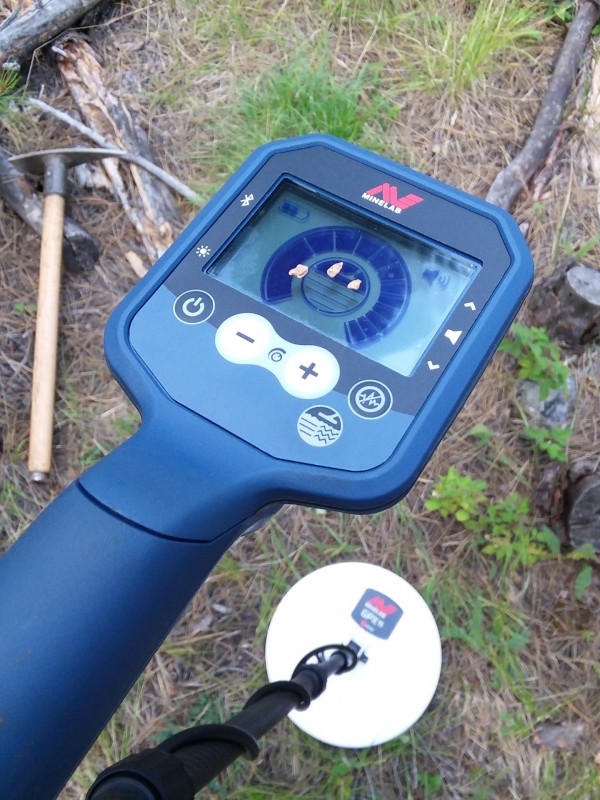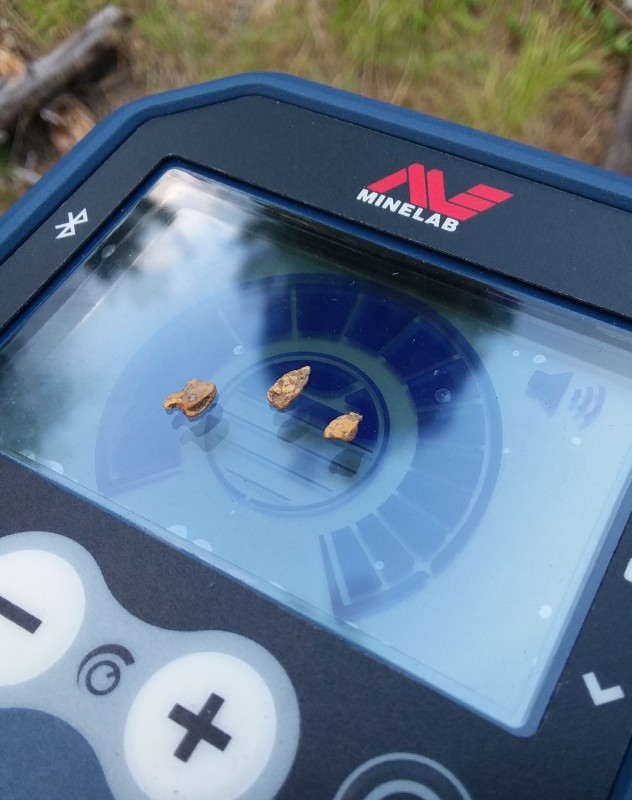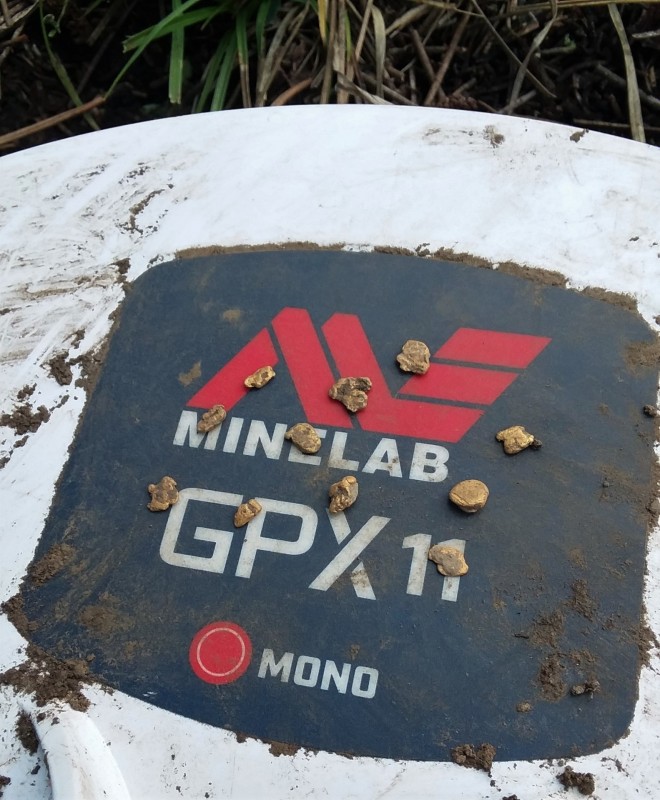-
Posts
2,206 -
Joined
-
Last visited
Content Type
Forums
Detector Prospector Home
Detector Database
Downloads
Everything posted by Gerry in Idaho
-

Depth Of 6000 On "larger" Gold Gerry ?
Gerry in Idaho replied to aerospace guy's topic in Detector Prospector Forum
Thanks for reaching out and asking questions on depth. Rob is correct about the variables that change the outcome. I and a few of my customers have dug many nuggets with VLF detectors at depth of 10" or more and a few closer to the 14-16" range. This nice prize was found at the 14-16" range and the 15x12" coil is in the hole to show depth. I'll be honest though, they are not small gold. Even this year I have dug nice specimen gold at 12"+ so I'm good with those depths. This one was found using stock 11" coil and found at 12-14" As for getting depths in virgin soils (undisturbed ground) like we hunt in much of North Nevada on small solid nuggets (Rye Patch type gold) I can get a VLF technology detector approx 4" to 5" on a 1 gram. A 1/4 ozt approx 6 to 8" and a 1/2 ozt approx 10". I dug a 3/4 otz nugget many years ago with a GB-2 and 10" coil at Rye Patch that was every bit of 10" in virgin soil. Below are a few other nuggets I or I was with customers that were dug using VLF detectors at depths of 10"+. Now take those same size nuggets and go into tailing piles and your depth greatly increases. Do you know why? Less mineralized soil and or black sands that the VLF detector needs to get through. That's why I enjoy hunting tailings more than virgin ground with a VLF. Plus the VLF detector is lighter and faster than bigger PI's and has better iron identification. Here is the issue with many that hunt for gold with a VLF detector at such sites like Rye Patch, Quartzsite and other well know nugget producers. If you go where others who have hunted using big PI's and or GPZ's in the mentioned sites, you are best not to use a big coil on the VLF detector. You're better off using a small coil to get the best results on tiny nuggets. Bigger machines, especially SD/GP and early GPX models miss many small nuggets as that is one of their weaknesses. So you need to take that knowledge, get your VLF and put in the smallest coil you can get and then go find the tiny ones they missed. Below a prime example of using a VLF detector with small coil to find a tiny nugget Trying to put a big coil on a VLF detector so you can match the depth of a PI is just plain ridiculous for most (not all) known nugget producing grounds. VLF's can not handle the soils and will not perform near as well as a big PI machine. BUT...if you use the VLF in tailing piles with no soils or mixed, then your depth of the VLF will go up and you actually could use the stock coil or on a rare occasion go big. Not saying the bigger PI's are not good in these situations, but the weight of the bigger detectors are excessive and their Iron ID capabilities are not as good as todays VLF's If I was on a budget of $3000 to find as many kinds of gold possible, here is a good setup I would consider. My #1 selection for VLF (at this time) is the Equinox 800 with stock coil and a small 6" round coil. Cost for both detector and extra small coil approx $1100. The other detector would be a used (from a dealer who knows how to test it properly) GP-3000, GP-3500 or GPX-4000 detector. This is your power detector to get nice nuggets at depth in most all soils. These detectors can be picked up for $1000 to $2000 and are proven winners when it comes to 2 gram nuggets and up at depth (better than a VLF). Hope this helps and if anyone else wants to add, please feel free. -
I wanted to share some pics of my last hunt with the GPX-6000 as it was fun to dig a little bigger and deeper gold. This site was much different than my previous 2 gold hunts (Success in Dakota & Wyoming) as it produced quite a few hot rocks for a PI detector. Now yes I can easily spend the time to do the "lift coil as I swing across signal and listen to how fast the signal target dissipates" method (I'll post it later) or I can easily change the multiple of Settings on the GPX-6000 (very confusing detector)🤔 with the 2 timings (Normal or Difficult). Anyway, I pushed the pad on the LDC screen to DIFF and the hot rocks where gone. Pretty easy there. I ran SENS/GAIN at 10 -which is MAX and had THRESHOLD on. After about 20+ small lead birdshots (this detector is a birdshot king), I get a little stronger-slightly more broad of a signal. It immediately sparks my interest as it's a big different than the lead pellets. I book scrape the 1st inch and target is still there, boot another almost inch and still there. Now I pull the pick and take another 1 1/2" off and now am actually into what I consider virgin layer. Quick swing and yet the target comes through very easily. So as to make sure I catch it on video, I hike back to my wheels and grab the cell phone and another water. Trying to dig with an APEX (best pick on the market in my opinion) in 1 hand and the cell phone in the other, while trying to keep the phone on the hole is harder than you might think. Probably why so many people don't catch as many live digs, as you really do need a 2nd person to get the quality. Well no quality here, but I hope the video shows it? After a few digs, swing, digs swing t test and digs, I finally get the target out of the hole. I'm really excited at this time and just so sure I have my 1st really nice 1/2" nugget. The depth of the hole was approx 8" deep, maybe 10", but it was not the 12" I had said in the video as I thought a water bottle was 12" and afterwards my tape showed it to be 8". But I know the detector easily heard the signal 2 to 4 " above the target before I started digging. This piece of gold is not a solid 4.5 grammer, but is mostly gold on the one side and host rock on the bottom. A dense solid nugget of 4.5 grams should easily be able to respond much deeper as I have done it on many older SD/GP and GPX detectors. Hope you folks much success this Fall with your detecting adventures and I look forward to seeing your heavy yellow metal digs.
-

GPX 6000 On Small, Porous Gold
Gerry in Idaho replied to Skookum's topic in Detector Prospector Forum
Yes that's certainly some rough looking gold. Your description of "focus of detector and operator" is exactly what it takes to still find more targets from those heavily worked areas. Did you notice any difference when going from NORMAL to DIFFICULT on the signals before you dug? So far I have not missed hearing a true target when comparing, so far. -
I totally understand as I get folks all the time who purchase the new updated detector but to find out they really never did spend the time to learn their older unit. But at the same time, he asked questions and you never did answer any of his questions. You gave advice as if he is a novice and did not even know his detector when it fact he mentioned he has been detecting for some time and that he wanted opinions on a jewelry detector for lakes in the $600 to $800 range. No worries my friend and have a wonderful weekend. BTW, I still wish you would consider the Equinox as a tool in your gaggle of detectors. Happy Hunting and all is good.
-

Back From Alaska, A Different Version
Gerry in Idaho replied to Reno Chris's topic in Detector Prospector Forum
Well you certainly bring back many memories Chris from my AK detecting adventures. Part of the fun on DP is us guys who devote the time to explore/adventure with detectors and then share out stories, photos and finds. It allows others the chance to see/feel (with out the mosquitos) and enjoy the trip. Glad you were able to stretch the back (get exercise while chasing gold), actually find quite a bit of Au and were able to come home safe. Hopefully the back get to heeling more and we see you in the NNV fields this Fall. Nice pics too. -
Nice crack gold and it all adds up at the end. Thanks for sharing.
-
Mike, We know you are not a fan of the Equinox detectors, but come on, lets be real. That comment you made is not even close to the truth. 1st off "most jewelry finds" are from salt beaches and you/I both know the average detector will not stand a chance to an Equinox in salt water. Most detectors are not even waterproof. 2nd is black sands and other soil mineralizes of so many fresh water lakes, the Bounty Hunter you speak of does not have the technology found in the $650 Equinox 600 to get best performance in varying soils. How about hunting the lake around pier's and seeing all the rusted iron targets from the many nails around piers and docks. The BH processor speed is nothing like an EQ. I'm not saying the Equinox is the best jewelry detector, but recommending a BH is just silly. You use many detectors and enjoy them for their different tasks, but yet you refuse to learn the Equinox? Yes everyone should run out and by some Bounty Hunter detectors so they can find the majority of jewelry in my pics. Just make sure the jewelry is floating in air so the BH can see it with no issues. That's right, the BH is just as good and that's why so many jewelry hunters are sharing their jewelry finds. Not... The original poster didn't ask for input on the detector he currently owns, he asked for input on a detector in the $600 to $800 range. That's exactly what I recommended to him. He mentioned he has been detecting for several yrs, so telling him a $199 BH is just as good as an Equinox? Here is where I might come close to agreeing with your reply Mike. If he said he wanted to hunt jewelry in parks and ball fields, then yes the majority of detectors, including the cheap BH's would be fine. Either way, we all have an opinion (including me) and sometimes it just comes from the wrong end.
-
Terry, So good to see you again on DP and hopefully things are going well back in NC. Last time we chatted I think you met me at Atlantic Beach and I showed you a water detector? Those that don't know Roughwater (Terry), he's a long time ago client of mine who drove out to NV and took one of my classes, this had to be early 2000's, maybe 03/04? Is this your rig you drove across the USA Terry? During the training Terry scored the gold he selected as his name on DP. Those were great days and it's amazing we still find stuff out there. As for the EQ-800 and seeing gold targets the bigger detectors do not. YES that's a fact and something I now share (have been for the last 10 yrs) during the 3 Day Field Training. Yes the Equinox 800 is a capable detector than can find smaller bits of gold a Pulse Induction or the GPX can not see. Also, the 800 can find high grade ore from hard rock piles the SD's, GP's, GPX's (including the new GPX-6000) and the GPZ can not see. The pic below is over an ounce gold Au after crushed (13 pieces) and my GPZ-7000 did not hear one of them. The EQ-800 found them all. Pictured below is an Idaho Specimen (1 of many) the bigger detectors can not see. And finally here is a nice wire gold specimen the big detectors don't see. Yes I get people who will down me and think I'm trying to talk down a GP, GPX and GPZ, but when I offer a friendly bet for their bigger detector, they back down. So many know it all snowflakes on the forums and social media these days, I get to the point it's not worth wasting my time. In actuality for me and those of my customers who know, it's just more gold for us as we realize the importance of still TODAY needing a quality VLF gold detector and because of the features on the EQ-800, my staff and I prefer it. Are there other VLF's that can see these types of gold better than the big machines? Most certainly and the new named Garrett GoldMaster 24K model (previously White's detector) is still one of my favorite "Gold Only" VLF detectors. So which ones is best? I wish the answer was that easy and some people think it is, but since I spend so much time in the field in many states and 2 other countries on occasion hunting a variety of kinds of gold with so many different detectors, it's kind of silly in fact, but the knowledge gained has helped me understand more than the average dealer and or customer, what the capabilities and or lack of the different detectors and what they see and or can't hear. By no means does this make them a bad model of detector, it's just the facts. There is not one detector that does all the gold, but there are a couple that do the majority of gold and that's what's most important. As those who have taken the training know, we enjoy comparing detectors, technologies and coils to targets in the ground and as we remove soil and get closer each time. This allows us to see when and or how close a certain detector or coil can start hearing a real signal. See pic below. What do my Field Staff and I enjoy most for our gold hunting detectors? The Equinox 800, the GPX-6000 and the GPZ-7000 in no particular order. Yes I still have staff who are using the GPZ-7000 but only for the certain situations. If I could only afford 2 detectors, then the GPX-6000 and EQ-800 would be my 2 choices. Hopefully this helps everyone as I realize most folks don't have the means to test the majority of detectors and on many variations of gold nuggets, specimens and ore dumps. The reality is in the US, there actually is quite a bit of gold left to be found. Just need to make sure you have the right detector (tool) for the task. Later this summer/fall I'll be doing some serious comparisons and testing of my specimens to see how much better than GPX-6000 is vs the GPZ-7000 as I know the GPX and it's improved technology will outperform the almost 7 yr old technology of the GPZ. But by how much is another question. In my opinion who cares? The other benefits of ergonomics, weight, and such already spoken about of the new GPX-6000 are already proven.
-
Yes, both the EQ-600 and EQ-800 are advertised as 100% waterproof.
-
Pretty open question as if you don't want to miss a single piece of gold jewelry (including gold/diamond stud ear rings), then a Fisher Gold Bug-2 would be my #1 choice. Now to be honest most folks are not good enough to find a gold stud but a gold ring is actually pretty easy and I feel for the price the Minelab Equinox 600 would do you best. it's my # go to for jewelry hunting for some of my Field Staff and I. My reasoning - it's 100% waterproof, runs Multi IQ technology so it can handle ground minerals better than most. It has auto Ground Balance for those who don't know how to do a manual GB, has tone ID to help separate the coins from low tones and also has VDI #'s to assist as well. Most gold rings read single digit to around 16 and some could reach higher.
-
Brian, You certainly were one of my harder sales but that's part of it. Not all people accept knowledge from a salesman as fact and since the GPX-6000 is still pretty early in it's release in the US, I realize there will be those who don't understand a $6000 detector being overall better than an $8000 model. It's the same with the Equinox 800 at $950 vs the CTX-3030 at $2500, it's just hard to see why the manufactures would do that. All I know in my 25 yrs around Minelab, their Engineering do not go backwards when it comes to their technology. I'm glad I was able to make you a believer. Sometimes the truth has to be earned in the field and you willing to take me to your patches is exactly what I knew would seal the deal. Hopefully when the new GPX-6500 with Iron Discrimination comes out, you won't need such hard face to face field teaching facts, although that might be a good reason to come back. As you know, my full time job is selling metal detectors. Part of what I enjoy most is the meeting of people, educating folks on detectors (that's why my staff and I offer 3 days training) and being able to adventure the country/countries with detectors and provide knowledge to folks in the field. At the same time, I get to learn new areas, ground and possibly find some gold or other treasures. The real gold in all of this though, is the fun with the friends and helping them become proficient with their detectors. My business plan is to be in the field which can then build long term relationships. When I'm in the Carolinas with customers like I was earlier this year and watching them dig their 1st Civil War Relic, or I'm in gold fields with folks and seeing the smile on their face as they score their 1st of many gold nuggets, that's part of what my staff and I enjoy most. We cherish seeing Success from those we helped and seeing their smiles. Your research and foot work has put you on some gold, your preferred detector dealer has proven the newer tools work to put more gold in your pouch. Your willingness to share you sites and get us the permissions on the property shows how golden you and your wife were to my stay. I sure hope she is able to join you more in the field and I most certainly will remember the great eats, stories and entertainment. Thanks for taking the time to give your input on the new GPX-6000 and sharing the pics of heard earned Success. One thing I noticed. I can remember you telling me a few times of your weekend hunts and not finding gold with the 7000. No worries, I do that quite a bit. But you made a comment in your post I found very interesting (if I read it correctly). You have not been skunked yet on your trips with the GPX-6000? Now that really does say something about this detectors capabilities. Thanks again for the opportunity to allow me to spend time with your family, Dan and gold sites. Memories forever.
-

GPX 6000 Covers On The Way To Your Local Dealers
Gerry in Idaho replied to Doc's topic in Detector Prospector Forum
For all my customers who have purchased their GPX-6000's, YES I have the new body cover kits in stock. Give me a ring and I'll get a set out to you www.gerrysdetectors.com Thanks again Doc for protecting our investments. -
Sometimes those snakes are protecting the gold. I've seen some log size rattlers in North Carolina and have heard they are just as big in TX. You ever eat them? These are some of the North Nevada types we run across. Not near as big and usually not very aggressive. As I have aged and get more educated, I usually don't kill them anymore. On a rare occasion if at training site and plenty people/dogs around, then one might need to be extinguished. The rest of them are fine with me.
-
Most folks have no clue how the majority of manufactures go about getting a detector in the field for testing. 1st off in my 25 yrs of working with different MD companies, they send you a mostly completed and or complete unit (yes it has already been decided how built) and that's exactly what ends up in the field. Being in the US, and able to test previous Minelabs, by the time I get proto type it's already a done deal and so my feedback is to late. Since the detector has already been built, not much on the external frame can or will be changed. They realize this and also know the overall product, performance and acceptance is what really matters. Many of us on here are perfectionists and so we'll find something not to our "high standards" and make it know. That does not mean it's a bad design, it just implies that we are hoping there will be a fix down the road. And if not, then we'll swing it anyway as we like the majority of things about the product. I personally have yet to swing the 17" coil so I can't reply about how it will twist the shaft, but I know this. It has happened a couple times with my 11" coil and I had no major issues with it, just twisted it back. Heck look at the Gold Monster 1000 and that shaft set up? That's one I personally don't like at all, but do you think it slows the sales of the detector, heck no. Speaker issue - I have not noticed it yet and I have only used the GPX-6000 with the speaker, no headphones. I imagine when I get to Rye Patch and the wind gets to really howling, I might need to go to the headphones and see how they work. Then again, the speaker is one of the loudest I've ever head on a detector, which is good in my books. Most of us are spoiled kids with high end toys and as JP and Steve said. We are missing the main points of this new detector and it's capabilities. It's finding us more gold at our old sites, it's easier to use and most importantly it is much better on ergonomics/weight and on our bodies. It gets us excited and wanting to go out and unwind from the daily does of shit that's all around us. A win win in my book, so no use in wine. and as Steve said...At least I have a cup.😀
-
I was waiting to hear your report Peg as I knew you would not sugar coat anything. Your report reminds me about a 3 day weekend date with a stranger. At first, you are at odds of the situation, the conversation and the nagging sounds and realize it's not what you normally expect. But the nice firm buttocks you keep checking out is a winner so you advance to a 2nd date. Day 2 you are finding a few things in common and think there's actually some hope as you see the potential and are realizing some chemistry is there. By day #3 you are much more relaxed with the date, starting to have a little fun, flirting a flash here and there and willing to let your hair down. That last day you are most comfortable with the situation, know how to push the buttons and getting used to the response. At the end your efforts are rewarded for putting in the time of 3 days on a trip, which allows you the prize of more gold nuggets. Nice to see you add 9 more N NV nuggets to your collection, but what's most important is the learning and acceptance of a new date/swing/detector and the benefits of it. Yes to you and the rest of the folks who know their 7000's, there is a learning curve to the GPX-6000 as you said it right "memory" of swinging a 7 and not having a harness, not knowing where the sound is coming from, no swing arm. I personally used the speaker of the 6000 on my trip and never did use the headphones. Sorry to hear you two had problems with the Aventree Torus speaker system as I was thinking of getting it, but might wait a little longer, as said I used the speaker on the 6000 for my trip. Those nuggets are certainly some unique odd shaped pieces of gold and I suspect that's what we'll be seeing coming from those N NV patches we've been working for the last 25 yrs. Guess the solid ones (easy to hear) have mostly been removed from old technology. Were you two able to do any comparisons on the undug targets with the 6 vs 7? I know it takes extra time and effort so that's usually why so many people don't. PS. I think you found the little brother to one of mine I recovered in MX. In your pic the 2nd one down on the left side looks really similar but pointing right. The one I recovered looks like a brother, but swings left. Funny how we pick out some of the most bizarre shapes and imaginations of our gold. Well done.
-
My 1st in the field trip review of the new GPX-6000 and what I experienced. The info of my learning, field observation, side by side comparisons, thoughts and comments are in no means the final verdict of the GPX-6000. The reason I say this, is the way my staff/I 1st started training customers on the GPZ-7000 is not how we train them today. Things could change, software downloads might come and as we spend more time in the different gold fields our knowledge goes up. I had the opportunity to hit the hills and that’s exactly what I did as I jumped into the truck and took off 1000 mile drive (one way) for some new gold fields. These were not just any gold fields but of locations and states I have never hunted Au nuggets before. I was able to spend 5 days in lush green forests in Black Hills of Dakotas and also the high rolling exposed bedrock grizzly bear country near 8000’ elevation in WY. Both of these states are on my check list of “Needs to find a Nugget” states, as I am a man who enjoys the phrase “been there – done that”. I don’t think it makes me a better nugget hunter, but I do feel it makes me more rounded and educated as a knowledgeable Gold Detector Dealer. Day one was a soaking wet ground day and I was sure the capabilities of the GPX-6000 were going to be diminished as it had rained all night long. The nearby creeks were chocolate brown in color and swiftly running to their edges, which is pretty rare the end of July. Either way, I was going to do it as I’d already drove 1000 miles, the schedule was already made and I had 2 other Dakota prospectors eager to chase Black Hills Gold with their detectors. For this story, I’ll make up names as I don’t want to expose their identities and or ruin the permissions on the lands we were granted. Common names are great for such times like this so I’ll use the names Dan & Brian. Dan was stepping up his game from a proven VLF, the Gold Bug-2.. but we all know it’s limited depth, inadequate capabilities in mineralized soils and liking of hock rocks, to a new shiny Pulse Induction GPX-6000 (yes I personally delivered all the way from Idaho). When we arrived at the site and I was shown the actual patch (quite small in size maybe 20’ x 10’), I was impressed at the location and amount of moist green vegetation around us. The surrounding mountains and area was quite different than what my mind expected and the movie series (Deadwood) I watched. The actual patch had been cleared though and we were down almost bare ground but some areas had about an inch of grass root systems. Funny how a couple pieces were actually in the roots. Dan certainly was the eager one as he scored 1st gold of us 3 and in fact, I was still trying to understand my new 6000 when I heard him holler “gold”. It was nothing big, but it was his first gold in his first 15 minutes with his first PI, a new GPX-6000. Not long after, I had my first signal and when I called Brian over with his GPZ-7000 he could not hear it. Interestingly the first 2 targets I called him over, his 7 missed though they were not gold, but actually small lead bird shots. Then my 3rd & 4th signals were small gold and still this GPZ was silent. Now we are starting to see a pattern. Another Dan nugget.- In the back ground I hear Dan yip yip like a little kid and I thought, oh my they do have 1 ounce nuggets in the Black Hills, but quickly see, not the case. It was very impressive though and weighed over a gram, which was actually his biggest gold nugget in his young Au chasing career with a detector. How his face was shining, I could see he was totally on board with his new high end PI detector, which made me feel good. Finally Brian hollers gold and I could see a nice picker of .2 gram from distance. No, it was not the area I was swinging as he wanted me to be on the exact spot of his so called cleaned out patch, so I did not get to see if the 6000 could have heard, but I’m most certain it would have. The one thing about having 2 GPX-6000’s and 1 GPZ-7000 in a 60’ area and a power line running no more and 150’ from us, it did leave the GPX-6000 needing the Noise Cancel about every 10 minutes. Once I realized this and how fast the “NC” is complete (approx 5 seconds), I had no more issues. Yes the GPX-6000 needs to have the Noise Cancel done more often then I did with my GPZ-7000, that does not make it a bad detector, it’s just the best way to handle EMI. Back to the cleaned out GPZ-7000 patch Brian put me on. So far the targets I have been finding, the signal responses are all pretty clear/loud and I was impressed how easy the 6000 was indeed outperforming the 7000 in wet saturated soil with the detector settings running NORMAL GROUND, THRESHOLD ON, and SENS at 4 – 7. After a couple more nuggets his 7000 missed, I decide to go back over the patch, but this time I adjust the settings on my GPX6000 and adjust the SENS to 10 ( Not Auto +1 ,but actual 10, which is MAX). I am not recommending newer users of this detector to go there right away, as my ears have been listening for gold targets in mineralized soils with a Minelab PI for 25+ yrs and I usually can pick out odd sounds and patterns quite easily when compared to most newer hunters. Yes the detector is much harder to understand and more noise coming from it, but a trained ear helps. With the new HOT settings and me going back over the same 20 foot square, I get a really weak iffy signal that repeats half the time. I call Brian over and his 7 does hear something, but it’s just about the same and he says he would not have stopped. Well the one thing I know is when I get in a patch, I don’t leave any odd noise undisturbed. 2” later off the top and I am most certain to dig a nugget. Another 4” deeper (now I have removed 6”) and the 7000 is still having issues, but the 6000 is easily singing the Au tune. 2 more inches deeper (total of 8” depth) and I have the little solid .3 gram nugget out of the hole, most impressive. IMPORTANT OBSERVATION - One thing I noticed when I swung the 6000 outside of the patch area and into deeper wet soils at this site. The GPX would hear saturated reddish soil pockets and the narrow pocket ones did sound like a really soft deep target. I dug a few down 4 to 6” only to have the signal disappear. After doing this a few times and even on the actual patch I was fooled, I decided to test the assumed target spot in the “DIFFICULT” Soil Timing before I dig. Wow, what a difference that made. Each time there was a target, the DIFFICULT would still hear it but when it was just ground noise, the DIFFICULT timing cleared the assumed target and response was gone. I would love to hear others observations on this as I am sure there has to be a breaking point? The afternoon ended with my GPX-6000 TRUMPing the 7000 as I scored 11 nuggets in about a 20’ area of the old 7 patch. Brian did score a few on the outskirts with his 7 and Dan also dug a couple more. The 3 detector total was around 17 Black Hills Gold Nuggets, 1 happy customer Dan and a stunned Brian with a heavy GPZ-7000. The moral of the story, Brian is now swinging a GPX-6000 and finding more Dakotas gold pickers. Dan is in heaven as at one time he was trying to justify a GPZ-7000. I accomplished part of my goal, to prove the GPX-6000 will get most folks in the US more gold in their pockets with a better user friendly, lighter and less exhausting detector. And… I was able to check off the gold nugget recovery for Dakota “been there, done that”. Later on in the trip and after Brian witnessed the extra gold I was getting from his patch with my GPX-6000, he decided one needed to be in his hands. He also realized the majority of gold nuggets the people in the USA find are smaller gold of less than a half ounce, so the GPX-6000 will do him just fine. Would you believe me if I said, I just so happened to have another new GPX-6000 with me…SOLD. Just to give him some love, we did detect another site and he was the bread winner that day scoring 3 nuggets to my ZERO. I was busy stuffing my cheeks with nice sweet wild raspberries, they were everywhere at that site. Part #2 to come when I get more time…hopefully worth the read.
-
Fantastic finds NorthEast and glad you are taking a liking to the GPX-6000. Specimen gold is always hard to see for PI detectors and yes this machine is certainly doing a fine job. Thanks for sharing your experiences
-
Well earned Steve and the combination of VLF with PI is certainly most prosperous. Glad to see Garrett taking a great detector "the 24K" and continuing on with it. Looking forward to reading more of you AK adventure and how many times you had to fight of the big Brown Bears. Beautiful gold as well.
-

Gold Bug 2 Finally Gets Upgraded
Gerry in Idaho replied to phrunt's topic in Detector Prospector Forum
I wonder how much money they actually put into the new version GB-2? In my opinion, what a waste of time, labor and efforts. No wonder FT is going in the wrong direction. Just a matter of time and they'll be Amazoning their own burial. So sad to see another American detector company fading away. Maybe time for new management as the last few yrs has not been friendly for us dealers. -
If the 6000 has the same depth on larger gold as my old GPX-5000, I am one happy customer because I've dug some pretty deep big gold. If the 6000 has better depth and cleaner signal on small gold than my old 5000 and is even on par with my heavy GPZ-7000, I am even more happy. Some folks are saying it's even better than a 7000 on small gold? I have not proven that yet in a variety of sites/soils and different kinds of small gold, but I get a feeling it's true. We already know the 6000 has the best balance, weight ratio and ergonomics. Thanks for helping straighten out some of the discussion JP. Most of us actually do rely on your hours and hours of footwork and testing knowledge and so thanks again.
-
AussieMatt replied pretty much spot on in so many ways. As a long time multi line dealer (Minelab 25 yrs) and one who has been pretty up on the gold detectors as the majority of my sales (until the Equinox 800 came out), I see this happen all the time. I'll add a little new thoughts and also tell of some sames from past. 1st is the guys who know what their doing and having great Success with their old detector. In the 4 yrs they have had it they've spent the time in the field to figure the strong points of it and the not so good parts of it. This allows them to concentrate on what that detector does best. So when the new detector comes out they assume it's going to be better than their GPZ-7000. Well the 6000 actually is in many aspects, but yet there's going to be a few things the 7000 is still best at. Instead of the person not taking the time to fully learn the pros/cons in a variety of soils, sites and kinds of gold, the person is upset and decides to dump it. Here is a prime example. One of the well known members on here (starts with a J) made so much of a stink with Minelab USA, to me and anyone they came in contact with about the 7000 and how their GPX was seeing gold the new 7000 did not. This went over for a very long time and I finally got to the point and realized the person is not as good as they claim and does not have the patience to learn a new detector. Now and for the last couple yrs the person is using and praising the GPZ-7000. Even to this day, I have a husband/wife team who purchased 7000's and after a few trips in the field went back to their GP's. They down talk the 7000 today. So you are going get a % of people who don't want to spend the time to learn the +/-'s of the new and would rather go back to what they know, which is the old. 2nd is the newbie. They have been watching folks find gold nuggets and decide this is the detector they want to jump on and start their gold hunting career/hobby. After a few trips to the field and realizing you must actually have to work to find your gold, they blame the detector, dump it and never admit it was their inabilities not the detector. Part of this is actually the manufactures fault for allowing just about anyone in the US to become a dealer. Minelab USA is really bad at this and could care less about directing customers to known knowledgeable dealers. For yrs dealers were promised those who took certain classes or did amount of training would stand out on the dealer website. Just talk is all they are. Newbies should be purchasing from someone who can help them grow into the hobby as gold nugget hunting is one of the hardest of metal detecting. 3rd is the poor guy who does not wear the pants at the house. His buddy gets a new GPX-6000 so he decided to do so and forgets to ask his wife/boss. When package shows up there is a little heat at that house for a few days. When the credit card bill shows up, there is smoke coming from the house and the guy has to dump it to pay bills. 4th is the person who has yet to purchase the new detector so they have no clue how well it really runs or what issues it has, but they enjoy bringing anything they see that could be negative. Most of those folks are not well known nugget hunters. On occasion we get a few known nugget hunters and they are a little bias. 5th is the person who actually knows their GPZ-7000 and is very well versed on most popular gold detectors. That person spends their one money, goes out to a variety of sites and puts time in the field comparing testing, tweaking and learning the new GPX-6000 and it's pros/cons. That person is well respected and has found more gold with a variety of detectors than the average Joe. If that person keeps saying there is issues, they are probably correct and things will need to be changed on the new detector. Every new release of a seeming popular detector will get a % of people who decide to get rid of it for 1 reason or another and early on in my own detecting career I did this myself a few times. But after time I eventually came back and realized I did not give the detector it's do time in the field...I made quick observations on a couple sites and or hunts and thought I had it figured out. How silly of me. Just like the CTX 3030, the Equinox 800 and the GPZ-7000, this new GPX-6000 is software download capable so as more time is in the fields across the world, the ability of a software fix is there. Those of us who owned an early GPZ-7000 know how this goes and that's a big plus for me. Those on the fence about the GPX-6000, just realize Minelabs track record speaks volumes and they don't mess up when it comes to detector technology. Is the 6000 the best high end gold detector for every situation? No and I will tell you there is not a detector today that is and there will never be a detector that is. I'll say this and you can take it to the bank. The GPX-6000 will be the most sold, most talked about and most used high end gold detector in the United States for the next few years and most folks will be happy.
-

Wade The 1 Armed Warrior And His Gpx-6000
Gerry in Idaho replied to Gerry in Idaho's topic in Detector Prospector Forum
Norvic - You know what happens to us who chase the yellow metal for so many yrs. The sun beating down all day, the solitude of the bush and other things day in day out. Next thing you know, we're talking to objects around camp and giving them names (kind of like that airplane pilot who crashed on an island and lived with a volleyball). Yes it's the Au fever and each of us have it just at a different level. You right though, a couple/few grams short...of a pound or two each year and I'll continue to be. But the reality is I can't have fun without new customers and or friends. Thanks for being there. Lunk - Heck I really never even seen how you set his detector up but I did notice that last one was about 10-12" deep. Glad you were there to keep him grounded after the gold...he was pretty Texas stoked. Gold Catcher - After this covid shit is over (seems to be creeping back up) and all is normal in CA (is that even possible?), I might actually head West to try my luck at scoring a coastal nugget or two. I'll be sure to reach out ahead of time, so as not to make the news of an out of state gold prospector found dead, after walking into a pot field. Actually I think it's legal there now right? Valens Legacy - With my business it's never an upsell and won't be. Getting to know the customer and their needs before the sale is most important. Offering additional knowledge and the opportunity of Field Training down the road is actually 2 fold as the new prospector gets to learn from Pros and at the same time the 3 days in the field is building long term relationships and camaraderie with my staff/I. Here's a funny fact many don't realize. You can not purchase a detector from from my website (I have no shopping cart). Do I lose business that way? Most certainly and I don't really care. What I do care about most is getting the right detector of the 150+ models I offer into the hands of the customer so they have the best chance of Success at the detecting styles they wish to pursue. My Field Staff is a big part of my business as I have 9 different highly skilled detectorists in different parts of the US who are constantly trying to make the detectors perform better in a varying soils for different kinds of gold. The bottom line to me. A successful customer is a customer for life and if my guys/I can help that customer become Successful, my little non traditional MD'er business in Boise, Idaho will continue on. Must be doing something right as Gerry's Detectors has been chugging along just fine for 25 yrs now. Thanks for the kind words.


.thumb.jpg.180311db6cc7a5529a296db88d3f8d06.jpg)
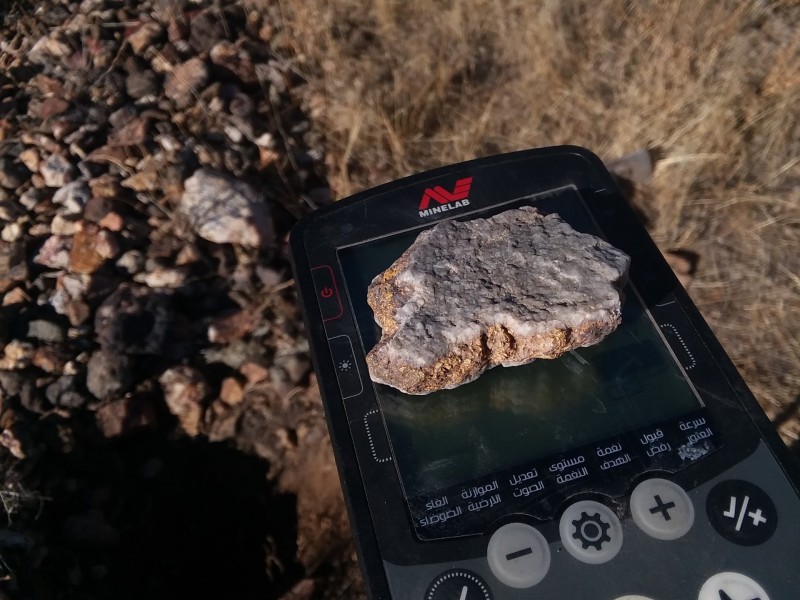
.thumb.jpg.14ee9e825849c19abc82a9269a58bdde.jpg)
